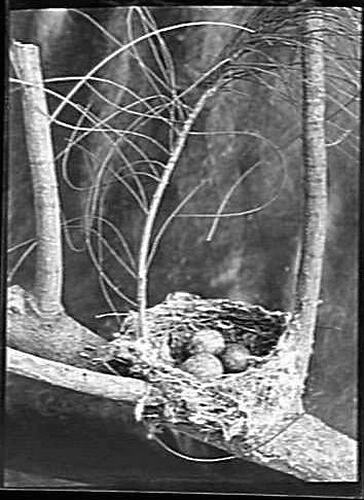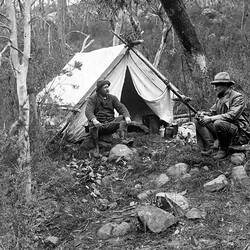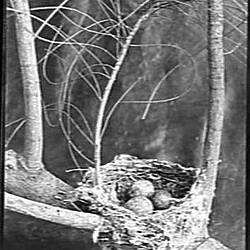WHITE-SHOULDERED CATERPILLAR CATCHER
Geographical Distribution -Whole of Australia and Tasmania (casual), also New Guinea.
Nest - Small and shallow, loosely composed of fine stalks of plants, bark, grasses, with the addition of cob-webs, chiefly on the outside, and situated generally in the uppermost pronged branches of trees or saplings, sometimes on a dead horizontal branch. Dimensions of a fairly-sized nest, 3 inches over all, by 2 inches in depth; egg cavity, 2 inches across by 1 inch deep.
Eggs - Clutch, two or three; roundish oval in form; texture of shell fine; surface glossy; colour, light or dull warmish-green, somewhat heavily blotched, especially about the apex, where the markings are confluent, with umber or reddish- brown and dull-slate. There is considerable variation in the ground-colour, which is lighter in some instances, darker in others, and frequently nearly covered with the reddish markings. Dimensions in inches of a proper clutch: (1) .81 x .64, (2) .79 x .63, (3) .78 x .65. (Plate 7.)
Observations - At one period or other of the year this bird is common to the whole of Australia. Its prevalence in the southern parts, however, is only noticed in summer, when it breeds, returning northward again in winter. It used to be well-known to collectors years ago in the vicinity of Melbourne, where in an afternoon two or three nests might easily be detected by the bird sitting in the topmost forked branches of black wattles (Acacia). The White-shouldered Caterpillar Catcher arrives at its most southerly limits about the beginning of September (I have noticed the bird in Riverina on the 1st, again at Mordialloc, Victoria, on the 19th), commencing to breed almost immediately, or by the latter end of that month. The breeding season continues into January or even February.
Both Gould and Gilbert agree that during that particular season the male birds become very pugnacious by attacking each other in a desperate manner, or by chasing the female from tree to tree, at the same time pouring forth his sweet agreeable song.
Gilbert's remarks of the bird in Western Australia apply accurately to our own in the east - that the nest is so diminutive that it is difficult to detect (except perhaps when the bird is sitting), and so shallow in form that it is quite surprising the eggs do not roll out whenever the branch is shaken by the wind.
During the progress of the Calvert Expedition in North-west Australia, numbers of the birds in immature plumage were noticed near Lake Way, in July. Near the Fitzroy River during February they were breeding, and several clutches of eggs were taken, which presented considerable variation in colour, some being heavily blotched with red on a pale-green ground, whilst others were streaked and blotched with dark-brown on a rich-green ground. The nests, which were as usual, small for the size of the birds, were built of fine grass, moss, cob-webs, and scraps of bark in the horizontal forks of the eucalypt and bauhinia trees, in such a manner as to make their discovery somewhat difficult.
From Mr. C. C. Brittlebank's observations it would appear that the male alone constructs the nest. He writes: - 'Re Campephaga, 17th February, 1897. Watched the male bird for over four hours in the morning, and about the same time in the afternoon, hard at work building the nest. His mate was nowhere to be seen. On the following day the same took place. This order of things continued until the nest was finished. We have observed this with three distinct pairs of birds.' Although the male in his conspicuous coat of black and white sometimes sits, he rarely or never feeds the young - he builds the nest, she feeds the young - a division of labour. Have any other observers noticed this?
Resources
Transcribed Archibald James Campbell. Nests and Eggs of Australian Birds, including the Geographical Distribution of the Species and Popular Observations Thereon, Pawson & Brailsford, Sheffield, England, 1900, pp. 103-104.
More Information
-
Keywords
-
Authors
-
Contributors
-
Article types


